Chapter 7 Three kinds of attentional selection
Because we have limited capacity, we need to attend to things for them to be fully processed. This is assisted by three abilities that we have:
- Location selection
- Feature (e.g., color) selection
- Object selection and tracking
In this chapter we’ll talk about location and feature selection - a later chapter will discuss object selection and tracking.
7.1 Location selection
People typically move their eyes to look directly at where they are attending when they are selecting a single location (overt attention).
But sometimes, people attend to multiple locations simultaneously. In that situation, their eyes have to point at one location, while they simultaneously attend to other locations. In previous units of study you’ve taken, location selection may have been the only kind of attention discussed. For example, in classic Posner cuing experiments (Posner, Snyder, and Davidson 1980), a location is cued, after which participants perform better at processing things in that location, because the participants attentionally selected that location.
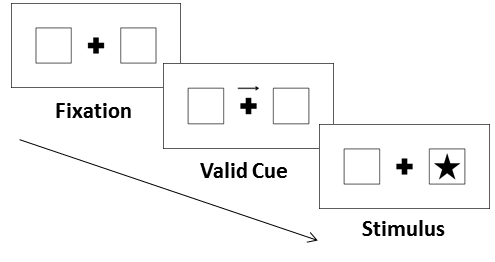
The schematic illustrates a shape identification experiment. The arrow cues the participant to covertly attend to the right while keeping their eyes on the center. The covert shift of attention results in participants identifying the shape on the cued side (the star) more quickly than if the arrow had directed the participant’s attention somewhere else. We’ll revisit location cuing in some new contexts in 12.
7.2 Feature selection
You might think that in order to attend to something you’re looking for, you first have to find it by moving your attention all around (location selection) to evaluate whether each region of the scene contains your target. That is true in some cases, but not all, thanks to the power of feature selection. Feature selection allows your attention to go straight to certain sorts of targets, as we’ll see.
Feature attention allows you to select an individual feature value, for certain features. One such feature is color.
In the below image, try attending only to the red objects. With some concentration, you may feel you can do it just by thinking of red.
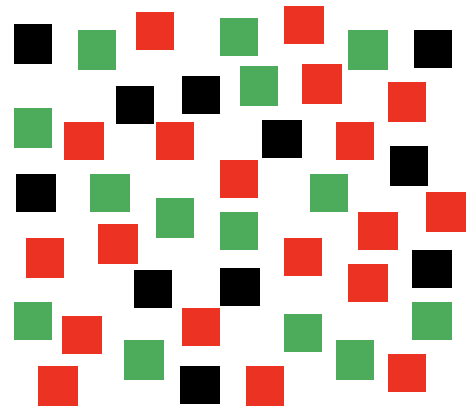 Next, try concentrating on all the black objects. Again, you can use your power of feature selection to do so. Similarly with the green - try it.
Next, try concentrating on all the black objects. Again, you can use your power of feature selection to do so. Similarly with the green - try it.
For any of these forms of selection to work as effectively as they do, your brain must be processing the color and the shape information simultaneously in parallel across the visual scene. If it didn’t, you’d be reduced to moving attention to each location to process its color and shape.
In the below, try concentrating on purple, green, or blue.

Feature selection also works pretty well for simple shapes. In the below, try thinking of squares, circles, triangles, or pluses.

Feature selection also is effective for direction of motion, allowing one to select, for example, upward or downward motion (Sàenz, Buraĉas, and Boynton 2003).
7.3 Feature combination selection?
However, selecting a combination of features does not work as well. You can think “green circles”, but unless your attention lands on them right away due to luck, it will take longer to find the green circles.
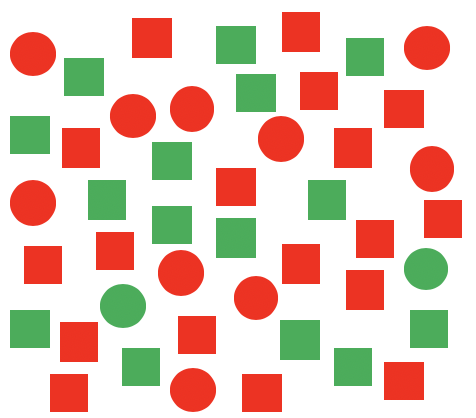 Your brain is unable to pick out a stimulus when finding it depends on a combination of features rather than a single feature.
Your brain is unable to pick out a stimulus when finding it depends on a combination of features rather than a single feature.
In the below three images, the target is a red circle in each case. In b it is easy to find the red circle, because it is defined by a single feature (color). in d it is also easy to find a red circle, because it is again defined by a single feature (simple shape). In f, however, it usually takes a longer to find the red circle. Selection of a combination of features is not effective.

7.4 Recap
Color, shape, and motion direction are processed in parallel across the visual field, in some fashion that allows attention to be guided to the instances of a feature that one decides to select. Researchers don’t fully understand how this works, but as will be decribed in 9, a theory proposed by Anne Treisman claims that there is a separate map for each feature, which can guide attention.
Whether the mechanism turns out to be a feature map or something else, when we think of a particular color, shape, or motion direction, our brain can enhance activation of the associated neurons rapidly. But we can’t do so for a particular combination of color and shape. Instead, we end up enhancing the activation of both the objects that are that particular color and the objects that are that particular shape; we can’t confine our attention to those that have that combination of features. For example, if the color is red and the shape is circle, we’ll activate all the red objects (even if they’re squares) and all the circular objects (even if they’re blue), rather than just the red circular object.
7.5 Complex shapes
While shapes that differ dramatically from each other allows parallel selection, like of the circles versus squares above, we do not have the ability to have our visual cortex enhance all instances of a complex shape.
In the next search array, your task is to find the shape that does NOT have a squiggly tail.

The search array is below. Find the target - the object without a squiggly tail.
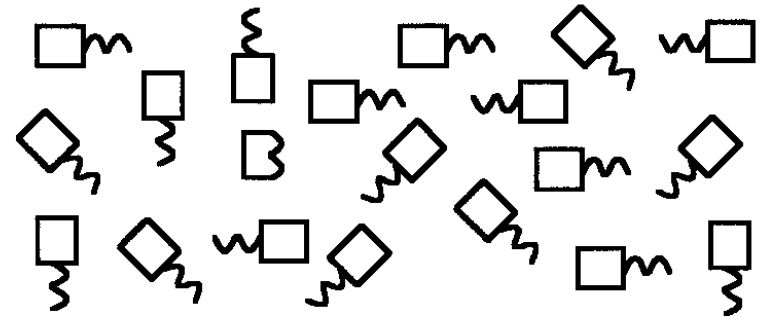
Finding the object without a squiggly tail takes, on average, much longer than in the simple search cases described in previous sections.
How quickly can you find a lucky four-leaf clover?
 Finding a four-leaf clover is hard! One reason is that feature attention is not effective for complex shapes (another reason, in the above display at least, is that the clover is small and crowded, so you have to look at each patch almost directly to perceive its individual leaves).
Finding a four-leaf clover is hard! One reason is that feature attention is not effective for complex shapes (another reason, in the above display at least, is that the clover is small and crowded, so you have to look at each patch almost directly to perceive its individual leaves).
Even fairly simple shapes like a ‘T’ can be beyond the powers of our featural shape selection. I wish we could just think to ourselves, ‘T!’, and enhance the activation of any T’s in the scene, making our attention go straight to their locations, but we can’t. So, on average it takes quite a while for attention to go to the location of the T.
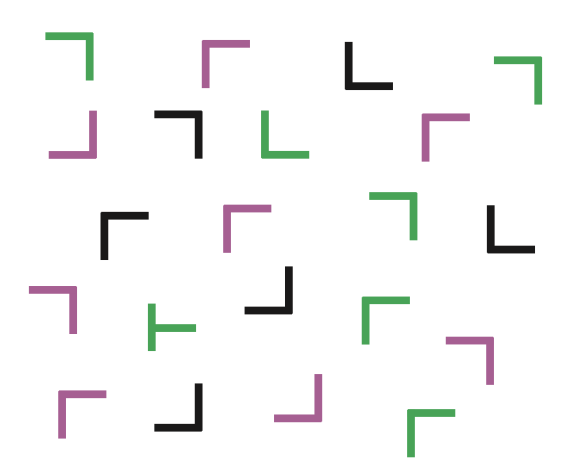
In summary, while we have some ability to do featural selection for color, shape, and motion, we can only do so for very simple shapes. Something about how the brain is connected up allows us to think “red” and quickly attend to all the locations in a scene that contain red, but this ability extends to only a few features.
7.6 Exercises
Answer these questions and relate them to the seventh learning outcome ( 2 ):
- What does “feature selection” mean?
- What kind of selection is Posner cuing an example of?